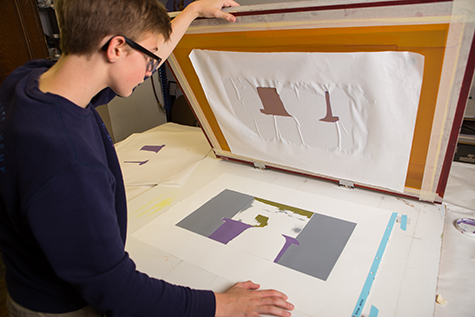The Essential Guide to Recognizing Screen Printing and Its Versatile Uses
Screen printing has a rich history that dates back to ancient times, evolving into an innovative method used throughout numerous industries today. This guide discovers the ins and outs of the screen printing process, outlining its applications in marketing, style, and home decoration - 10:9 Design Company. Comprehending these principles can open imaginative possibility for both creative and commercial projects. The adhering to sections will expose vital suggestions and techniques to improve one's screen printing ventures
The Background of Screen Printing
Although screen printing has roots that map back centuries, its advancement reflects the technological and artistic advancements of various cultures. Coming from old China, the technique was originally utilized for embellishing fabrics and later spread to Japan, where it ended up being indispensable to Ukiyo-e woodblock printing. The approach changed to Europe in the 18th century, where it got appeal amongst artisans and industrial printers. The creation of picture solution in the 20th century reinvented screen printing, permitting even more complex designs and better efficiency. Artists like Andy Warhol better drove its appeal, utilizing the tool to produce famous jobs that blended commercialism and art. By the late 20th century, screen printing had actually developed itself as a functional technique, used in vogue, marketing, and art. Today, it remains to progress, incorporating electronic technology and broadening its applications throughout different sectors.
The Screen Printing Process Explained
Screen printing changes creative visions right into concrete layouts via a collection of specific steps. Initially, a photo is created and after that transferred onto a screen, usually made from fine mesh textile extended over a frame. A light-sensitive solution is put on the screen, which is exposed to light, hardening in areas not covered by the picture. After rinsing the unhardened emulsion, a stencil is developed.
Next, the screen is put over the substrate, whether it be textile, paper, or one more material. Ink is after that pushed with the open areas of the pattern utilizing a squeegee, depositing the design onto the substratum listed below. This procedure can be duplicated for several colors, needing different screens for each hue. Finally, the published item is treated using warm to assure the ink adheres properly, leading to a sturdy, vivid style ready for usage.
Sorts Of Screen Printing Techniques

In addition, specialty methods, click site such as discharge screen printing, eliminate dye from the textile to develop softer prints, while foil screen printing applies metal foil to accomplish a glossy surface (10:9 Design reviews). Each strategy supplies distinctive characteristics, accommodating various innovative demands and manufacturing ranges, inevitably broadening the possibilities within the screen printing domain
Applications of Screen Printing in Various Industries
.png)
Additionally, the signs and marketing industries use screen printing for creating captivating display screens and banners. This approach allows for bold shades and complex styles that catch attention. In electronic devices, screen printing is used for applying conductive inks to motherboard, vital for part links. The home design sector embraces screen printing to generate distinct designs on textiles and wall surface art. In general, screen printing offers as a vital device across varied fields, boosting items with personalized and visually enticing graphics.
Tips for Successful Screen Printing Projects
While taking on a screen printing task, careful attention to detail can considerably improve the last outcome. First, choosing high-quality products is essential; this consists of the screen, inks, and substratums. Making use of proper mesh counts can affect ink deposition and detail resolution. Preparation is equally crucial; thorough cleaning of displays and proper direct exposure times guarantee crisp prints.
Next, precise registration is critical for multi-color prints. Using alignment devices can aid accomplish precise layering. In addition, testing prints on scrap materials before manufacturing aids recognize potential issues without wasting resources.
Frequently Asked Concerns
What Products Are Finest for Screen Printing on Textile?
Cotton and polyester blends are suitable for screen printing on fabric because of their durability and ink absorption. Furthermore, specialized textiles like silk or canvas can generate special structures and finishes, enhancing the general design high quality.
Exactly how Do I Clean and Maintain Screen Printing Equipment?
To preserve and cleanse screen printing equipment, one need to regularly wash screens with proper solvents, check squeegees for wear, lubricate moving parts, and store all products in a dry, dust-free setting to lengthen their life-span.
What Are the Environmental Impacts of Screen Printing?
Screen printing can have considerable ecological influences, consisting of chemical waste from inks and solvents, water use throughout cleansing processes, and power intake. Sustainable practices and environmentally friendly products are important for reducing these unfavorable results.
Can Screen Printing Be Done in your home Effectively?
Screen printing can be effectively done at home with the appropriate products and methods. Enthusiasts can produce high quality prints, though success depends upon their ability level, tools, and understanding of the process included.
What Are the Expenses Connected With Beginning a Display Printing Organization?

Starting a screen printing service entails costs for equipment, products, and workspace. Initial expenses generally range from a Get More Info couple of hundred to several thousand dollars, depending on the scale, top quality of equipment, and desired manufacturing capacity.
Screen printing has a rich background that dates back to ancient times, progressing right into an innovative technique used throughout numerous sectors today. Another technique, rotary screen printing, uses cylindrical displays, promoting constant printing on textile rolls, therefore improving performance for large-scale productions. Additionally, specialty methods, such as discharge screen printing, eliminate dye from the fabric to develop softer prints, while foil screen printing applies metallic foil to achieve a glossy finish. In the fashion sector, screen printing is widely used to develop lively designs on clothing, enabling brand names to showcase their distinct designs. Cotton and polyester blends are perfect for screen printing on material due to their durability and ink absorption.